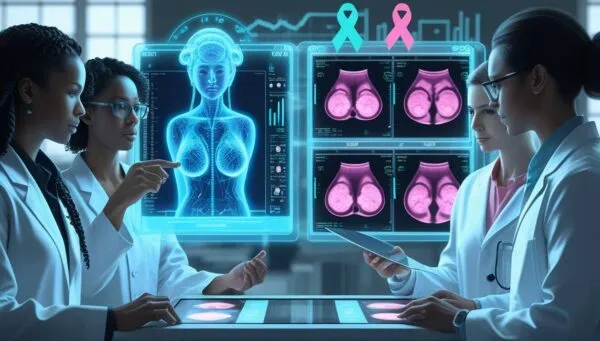Artificial intelligence cancer detection systems are revolutionizing oncology, with recent studies from Germany and Sweden proving their superiority over human experts in identifying breast and ovarian malignancies. These advancements promise faster diagnoses, reduced errors, and life-saving interventions for patients worldwide.
How AI Is Transforming Breast Cancer Screening
A landmark German study involving 500,000 women demonstrated AI’s unmatched precision in mammogram analysis. Radiologists using AI detected 6.7 cancers per 1,000 screenings—significantly higher than the 5.7 per 1,000 rate without AI assistance.
Key Findings:
| Metric | With AI | Without AI |
|---|---|---|
| Detection Rate | 6.7/1k | 5.7/1k |
| False Positives | No Increase | Higher Risk |
| Analysis Speed | 30% Faster | Standard |
Alexander Katalinic, a lead researcher, emphasized: “AI matches human accuracy in mammography but excels in consistency and scalability.” This efficiency addresses critical shortages in radiology staffing, particularly in rural areas.

For insights on improving healthcare access, explore our guide to poultry farming basics, a sector vital to community nutrition.
AI’s Breakthrough in Ovarian Cancer Diagnosis
Ovarian cancer, often called the “silent killer,” is notoriously hard to detect early. Researchers at Sweden’s Karolinska Institute trained AI models on 17,000 ultrasound images from 3,652 patients across 20 hospitals. The results were groundbreaking:
- AI Accuracy: 86.3%
- Expert Radiologists: 82.6%
- Non-Experts: 77.7%
Professor Elisabeth Epstein highlighted the implications: “AI bridges the global shortage of ultrasound specialists, reducing delayed diagnoses and unnecessary surgeries.”
How AI Classifies Ovarian Lesions:
- Benign: Slow-growing, non-cancerous masses.
- Malignant: Rapidly spreading tumors requiring urgent intervention.
Discover how diet impacts cancer risk through our article on ultraprocessed foods and child development.
Why AI Excels Where Humans Struggle
- Pattern Recognition: AI analyzes thousands of images to identify subtle anomalies.
- Zero Fatigue: Unlike humans, AI maintains precision during prolonged screenings.
- Data-Driven Decisions: Reduces subjective errors in diagnosis.
While AI isn’t replacing doctors, it’s becoming an indispensable tool. For example, AI’s role in quantum computing milestones showcases its expanding medical applications.
Challenges and Future Directions
- Regulatory Hurdles: Ensuring FDA/EMA compliance for AI tools.
- Ethical Concerns: Addressing biases in training data.
- Integration Costs: Upgrading hospital infrastructure for AI adoption.
For more on healthcare innovation, read about revolutionizing brain cancer treatment.







